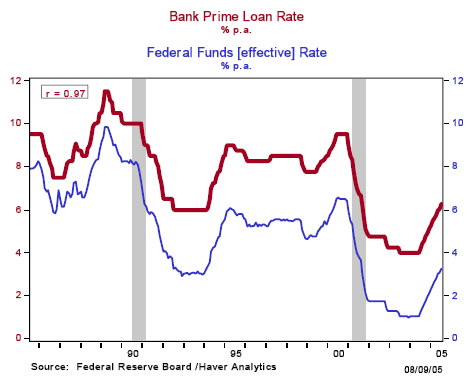This is an interesting question for many borrowers. The prime rate is a “reference or base rate” that banks use to set the price or interest rate on many of their commercial loans and some of their consumer loan products. The prime rate tracks fairly closely with other short-term interest rates, such as the overnight federal funds rate; this relationship is illustrated in Chart I. As of June 2005, the bank prime rate reported on the Federal Reserve Board’s monthly H.15 Release, Selected Interest Rates, was 6.01 percent.
The prime rate is a short-term interest rate
The prime rate shown in Chart I is the interest rate charged by the majority of the nation’s top 25 domestic commercial banks. One interesting feature is that the prevailing prime rate typically is uniform across all banks—unlike deposit interest rates banks pay, which often vary considerably from bank to bank depending on funding needs and portfolio considerations. While individual banks may change their prime rate at any time depending on market conditions, the prime rate tends to move closely in line with market interest rates. As is illustrated in Chart I, the prime rate (heavy red line) very closely follows the federal funds rate (thin blue line), the interest rate that banks charge each other on overnight interbank loans.
Chart I
The Prime Rate and the Federal Funds Rate Move Together

How important is the prime rate for business lending?
The prime rate remains an important reference rate for commercial banks, although its use has changed over time. (See “The Persistence of the Prime Rate,” FRBSF Weekly Letter (5/20/94)) The quarterly Federal Reserve statistical release, E.2, Survey of Terms of Business Lending, provides information on commercial and industrial loan lending terms, including information on the share of value of loans priced off of the prime rate.
According to the May 2-6, 2005 Survey, about one-third of the value of all commercial loans made by the banks surveyed were priced off of the prime rate. The survey also provides information on the weighted average effective loan rate for loans with a variety of characteristics.
However, the share of loans priced off of the prime rate varied significantly according to a number of factors including the type and size of bank making the loan, the size and maturity of the loan, how the loan was priced, and whether the loan was secured by collateral. So, which banks typically tie loans to the prime rate and which types of loans are likely to be priced off of the prime rate?
- Small domestic banks
The May 2-6, 2005 Survey indicated that domestic banks, particularly small ones, were more likely to price loans off of the prime rate. U.S. Agencies and Branches of Foreign Banks rarely priced loans off the prime rate—these institutions would typically price loans off of London Interbank Offer Rate (LIBOR) or other money market interest rates. - Smaller business loans, floating rate loans, collateralized loans
Smaller business loans tend to be referenced to the prime rate; at domestic banks, over 70 percent of the value of loans under $1 million in size were prime based. In the aggregate, more than 75 percent of the value of all floating rate business loans were tied to the prime rate. Prime-based loans were about twice as likely to be secured by collateral as other business loan pricing options. - Consumer loans
In recent years more consumer loan products also have been priced off of the prime rate including credit cards and home equity lines of credit. Interest rates on these adjustable interest rate loan products change with a published prime rate index, like the one published daily in the Wall Street Journal.
Sources of prime rate data
So, whether you are a consumer borrowing against your home or on your credit card with a floating interest rate like the prime rate, or a business-owner taking out a commercial loan priced off of the prime rate, knowing what the prime rate is and how it behaves over time is important to your financial well being. You can find historical information on the prime rate and other interest rates at the H.15 historical index page on the Federal Reserve Board’s website. Additionally, you may go to FRED, the Federal Reserve Bank of St. Louis’s database website and download prime rate data or create a chart showing the behavior of the prime rate over a period of several years.
Data
Selected Interest Rates (Weekly) (H.15)
Survey of Terms of Bank Lending (E.2)
Federal Reserve Bank of St. Louis. Website, see Economic Data – FRED.
References
Booth, James R. “The Persistence of the Prime Rate.” Federal Reserve Bank of San Francisco. FRBSF Weekly Letter. 94-20. May 20, 1994.
Dueker, Michael J. 2000. “Are Prime Rate Changes Asymmetric?” Federal Reserve Bank of St. Louis, Review, September/October 2000. Pages 33-40.
Laderman, Elizabeth. “The changing role of the prime rate.” Federal Reserve Bank of San Francisco. FRBSF Weekly Letter. Jul 13, 1990